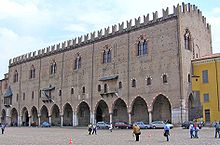Palazzo Ducale (Mantua)
The Palazzo Ducale (dt .: Ducal Palace) is a building complex of 14th to 17th century in Italian Mantua in Lombardy , mainly by the family of Gonzaga built as their manor.
The buildings are connected by corridors and galleries and enhanced by their inner courtyards and gardens. The ensemble comprises around 500 rooms on around 34,000 m². The palace is particularly famous for Andrea Mantegna's frescoes in the Camera degli Sposi (wedding room) in the Castello di San Giorgio, a free-standing building belonging to the complex, but also for many other architectural and artistic furnishings.
history
The oldest areas of the palace consist of the Palazzo del Capitano , built in the early 14th century by Guido Buonacolsi , whose family ruled Mantua from 1271 to 1328, and the Magna Domus . At the end of this century, Bartolino da Novara, one of the most famous military architects of the time, added the Castello di San Giorgio .
The Domus Nova was completed a century later by Luca Fancelli . He is also responsible for the Corte Nuova (New Courtyard), which contains the ducal rooms with the famous fresco cycles by Giulio Romano .
The Church of Santa Barbara , Palatine Chapel (Basilica Palatina) of the Gonzaga, was designed by Giovan Battista Bertani. In the 16th and 17th centuries, the architect and painter Maria Viani added the apartments of Vincenzo I and the so-called Room of Metamorphoses and the Loggia di Eleonora .
On February 24, 1607, Monteverdi's opera L'Orfeo was premiered in the ducal palace. The exact location of the performance within the palace complex is not known.
The Gonzaga inhabited the palace from 1328 to 1707 when the dynasty became extinct. The buildings then experienced rapid decline; a process that could only be reversed in the 20th century through restoration and its new purpose as a museum.
overview
The entrance is in Piazza Sordello, where the oldest parts of the building are, the Palazzo del Capitano and Magna Domus . The monumental Scalone delle Duchesse (Duchess's Staircase), built in the 17th century and enlarged by Paolo Pozzo in 1779, leads into the Morone Room, named after the painting by Veronese Domenico Morone (1494), which depicts the expulsion of the Bonacolsi in 1328 ( the action takes place in Piazza Sordello). In the piano nobile is the Stanza di Guastalla , with a frieze full of frescoes with portraits of the Gonzaga family, which originally extended into the next room, the Camera di Pisanello . Antonio Pisanello was commissioned after 1433 with frescoes showing a "tournament" and other unfinished scenes.
The Galleria Nuova is a corridor built by Giuseppe Piermarini in 1778 to connect the Guastalla apartments with those of the Duke. It houses several altars from the early 16th to the late 18th centuries by Francesco Borgani , Carlo Bononi , Spagnoletto and others. The gallery closes with the grandiose Sala degli Arcieri ( Archers' Room), where Vincenzo's apartment was once located. Famous is an altarpiece by Peter Paul Rubens (1605), originally part of a triptych in the church of Santissima Trinità in the city, which depicts the Gonzaga family in veneration of the Holy Trinity .
Finally, there is the Galleria degli Specchi (mirror gallery): built as an open loggia under Vincenzo I, with neoclassical decoration from 1773–1779. The vault was frescoed by two students of Guido Reni .
literature
- Michele Cordaro (Ed.): Mantegna. La Camera degli Sposi. Electa, Milan 1992.
- Mantova ei Gonzaga nella Civiltà del Rinascimento. Citta Mantova, Mantua 1977.
Web links
- Official website of the Palazzo Ducale (English, Italian)
- Palazzo Ducale . In: guideturistichemantova.it
- Site plan of the Palazzo Ducale (PDF)
Coordinates: 45 ° 9 '37.1 " N , 10 ° 47' 52.9" E


